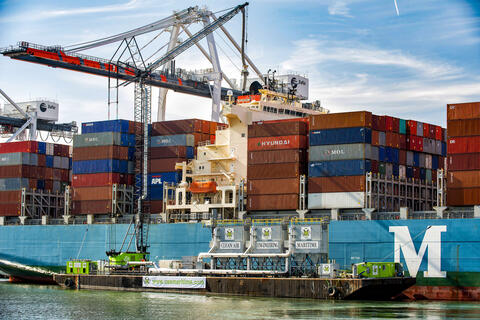Port of San Diego to Deploy Bonnet System to Help Further Reduce Cargo Vessel Emissions on and around San Diego Bay
Contact: bpage@portofsandiego.org, 619.348.1518, bpage@portofsandiego.org
As a national leader in deploying clean air technologies, the Port of San Diego is moving forward with a system to control and capture cargo vessel emissions, also known as a bonnet. The bonnet will be available for use by cargo vessels that aren’t yet equipped to connect to shore power.
In support of the Port’s new Maritime Clean Air Strategy (MCAS), the Board of Port Commissioners has approved an agreement with Clean Air Engineering – Maritime, Inc. (CAEM) to design, build, and operate a barge-based emissions control and capture system, also known as the Marine Exhaust Treatment System (METS), which will be certified by the California Air Resources Board (CARB).
For vessels that aren’t yet shore power compatible, the METS places a bonnet over the vessel’s stack to capture and treat exhaust while the ship is at berth. CARB requires the exhaust treatment to be equivalent to electric power at berth. CAEM has received CARB approval on similar technologies that remove over 95% of particulate matter and nitrogen oxide. Shore power allows vessels to plug-in to shore-based electricity so they don’t have to run their diesel engines while at berth. Having a bonnet in addition to shore power at the Port of San Diego’s cargo terminals – one at the Tenth Avenue Marine Terminal and one coming soon at the National City Marine Terminal – will help to further reduce certain air pollutants like nitrogen oxides and diesel particulate matter.
“The bonnet will give some of our cargo carriers a great option in reducing their air quality impacts while they work to transition their vessels to being shore power compatible,” said Chairman Dan Malcolm, Board of Port Commissioners. “This is another example of how we can maintain and grow our maritime business – and protect jobs – while also improving air quality and quality of life for all who live, work, and play on and around San Diego Bay.”
Nick Tonsich, President of Clean Air Engineering – Maritime added, “The Port of San Diego is aggressively pursuing every mitigation measure available to ensure the highest air quality of any port community. We are proud to work with the Port and provide our years of experience in this public- private partnership.”
The bonnet system supports the Port’s MCAS “Health Equity for All” vision – specifically, the goal to reduce emissions from ocean-going vessels. Additionally, CARB regulations require that auto carrier vessels reduce emissions while at-berth at California seaports beginning in 2025 by utilizing either shore power or bonnet technology. The Port’s National City Marine Terminal primarily processes automobile imports.
The total cost of the project is approximately $11.5 million, with the Port directing $4.9 million in grant funds received from the California Transportation Commission (CTC). CAEM is covering the rest. The bonnet system is anticipated to be operational by January 1, 2025.
CAEM was founded in 2010 and has over eleven years of working experience on over 400 vessel calls and 23,000 hours of vessel exhaust treatment. They are a full-service company providing both design and build as well as operations and maintenance of emissions capture and control systems. They have a successful operational history at the Port of Los Angeles and Long Beach.
The agreement is a good business deal for the Port. CAEM is providing up-front capital financing for the portion of the project not covered by the CTC grant and has agreed to the following:
- CAEM will design, build, and deliver to the Port a METS unit which is compliant with CARB regulations;
- CAEM will provide the capital necessary for the construction, delivery, and operation of the METS (subject to reimbursement of certain costs through grant funding obtained by the Port);
- CAEM will operate and maintain the METS during the duration of the contract through a revenue sharing arrangement with the Port;
- The Port’s share of revenue will be applied to reduce the capital investment of CAEM over time; and
- CAEM and the Port will jointly own the METS until CAEM has fully recovered its capital investment in the ECCS.
Other notable clean air projects in the works at the Port include:
- Doubling shore power for cruise ships in fall 2022.
- Installation in 2023 of two all-electric Konecranes Gottwald Generation 6 Mobile Harbor Cranes to replace the obsolete diesel mobile harbor crane at the Tenth Avenue Marine Terminal.
- The first all-electric tugboat in the U.S., being built and to be operated by Crowley, will operate in San Diego Bay beginning in 2023.
- In 2023, 16 new electric trucks and vans will replace gas- or diesel-powered vehicles in the Port’s fleet.
About THE Port of San Diego
The Port of San Diego serves the people of California as a specially created district, balancing multiple uses on 34 miles along San Diego Bay spanning five cities. Collecting no tax dollars, the Port manages a diverse portfolio to generate revenues that support vital public services and amenities.
The Port champions Maritime, Waterfront Development, Public Safety, Experiences and Environment, all focused on enriching the relationship people and businesses have with our dynamic waterfront. From cargo and cruise terminals to hotels and restaurants, from marinas to museums, from 22 public parks to countless events, the Port contributes to the region’s prosperity and remarkable way of life on a daily basis.
ABOUT PORT OF SAN DIEGO ENVIRONMENT
Port of San Diego Environment champions the safekeeping and environmental care of our diverse ecosystems. Year after year, environmental goals are set and measured to evolve environmental initiatives – ensuring San Diego Bay remains a vibrant resource and contributes to a remarkable way of life for visitors and residents for generations to come.
